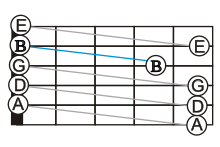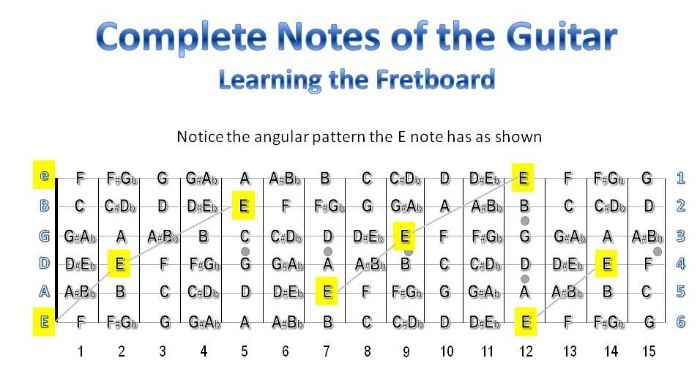
 |
|
#1
|
|||
|
|||
|
Based on recommendations elsewhere, have been reading Bruce Emery's Skeptical Guitarist Vol. 1 and came across a diagram that tremendously simplified learning fret board notes. (even though he was just pointing out how notes are organized)
This may be very obvious, I just never noticed it before. It seemed there really was no short cut to simply memorizing notes over time, and figuring everything out on each string starting at the nut. Bruce drew arrows from each string to the next (higher) from 5th to the next open string at the nut (4th on the G) showing how the notes repeat exactly from the 5th fret upward (toward the sound hole) duplicating the notes from 0-5 on the adjacent string. For example, the 5th fret on the low E string is A, same as the open 5th string. Then if you know a G and C chord in first position you probably already know the second and third frets on the 5th string are B and C. The eye opener is that you find these same notes duplicated on the 7th and 8th frets of the E string, just by mentally transposing them. (and of course, the high E as well) Anyone that knows first position chords knows how to find most of the notes for the first few frets as they relate to basic A, G, C, D, E and F chords. Now you find those same notes from the 5th fret upward on the next (lower) string. Once you have 0-5, and 5-10, you can also take the open string notes at the 12th fret, and step back one step to find the next note down - for example D on the 10th fret of the first string being one full step down from E at the 12th, and so on. And you're basically done. What previously seemed daunting, is now made simple. The only down side is I feel like something of an idiot for not noticing this sooner.
__________________
Martin OM-18 Authentic 1933 VTS (2016) |
|
#2
|
||||
|
||||
|
Figured that one out a long time ago (standard tuning of course). While playing it is somewhat useful when you have time to think and for some reason you need to know the name of a note. Generally I just want to be able to hear and play intervals. For that scale practice can help.
__________________
Derek Coombs Youtube -> Website -> Music -> Tabs Guitars by Mark Blanchard, Albert&Mueller, Paul Woolson, Collings, Composite Acoustics, and Derek Coombs "Reality is that which when you stop believing in it, doesn't go away." Woods hands pick by eye and ear
Made to one with pride and love To be that we hold so dear A voice from heavens above |
|
#3
|
|||
|
|||
|
All the tricks you can throw in your bag can make a big difference. I love Bruce Emery's style of teaching. I have a couple of his books, but not he Skeptical Guitarist series. The Travis picking one was very useful as I was learning that style.
__________________
Larrivee OO-05 Larrivee OM-03R Eastman AC308 Pono OO-20 Pono OP-30DC |
|
#4
|
|||
|
|||
|
Hmmmm....I need to see this diagram...
__________________
2006 Yamaha F200TXR 4 stroke. My Guitars - Yamaha FG700S Sandburst; Epiphone Les Paul Standard; 2018 Yamaha LL-16D Natural; Ibanez Talman Bass; Fender Standard Telecaster; Yamaha FG820-12 Natural; Yamaha FS830 Tobacco Brown Sunburst; ....A beginner practicing almost everyday since 12/15/14....{:::]==={=O=I} |
|
#5
|
|||
|
|||
|
I don't have the author's permission to copy and post his work, but it's kind of like this image, if you extended it to the right and filled in the notes. For example from A to D on the 5th string would be written starting at the 5th fret on the low E.
More than the image it's the idea of how the notes are organized, and that if you know them close to the nut, you also know them on the next lowest string from the 5th fret on up. 
__________________
Martin OM-18 Authentic 1933 VTS (2016) |
|
#6
|
|||
|
|||
|
I see now there are lots of ways to view a pattern in your mind that may help. Just have to find the one that works for you. I have never noticed this relationship as well and not sure it is a healthy method or not:
 
__________________
2006 Yamaha F200TXR 4 stroke. My Guitars - Yamaha FG700S Sandburst; Epiphone Les Paul Standard; 2018 Yamaha LL-16D Natural; Ibanez Talman Bass; Fender Standard Telecaster; Yamaha FG820-12 Natural; Yamaha FS830 Tobacco Brown Sunburst; ....A beginner practicing almost everyday since 12/15/14....{:::]==={=O=I} |
|
#7
|
|||
|
|||
|
Different strokes for different folks. I'm glad you found something that works for you.

|
|
#8
|
|||
|
|||
|
Quote:
There are many angles to view it from, and the more the better - they all support each other, and the quicker the jigsaw all falls into place. E.g., in your diagram, the diagonal lines link octaves of the same note. In Arthur's, the lines in the opposite direction link unisons (same note same octave). The slight glitch in the symmetry - the reason the E-E lines aren't straight - is the tuning of the G-B-strings (a major 3rd apart instead of the perfect 4th between all the others), which means the lines get a kink when they cross those strings. You'll find chord shapes (the 5 movable shapes in the CAGED system) will support these other methods too. Embed it all by playing it, of course, so your ear gets to support your fingers.
__________________
"There is a crack in everything. That's how the light gets in." - Leonard Cohen. Last edited by JonPR; 03-28-2017 at 07:42 AM. |
|
#9
|
|||
|
|||
|
Here with more notes you can see them repeating on adjacent strings, 1-5 same as 5-10. Never had much problem finding notes 1-5, so this simplifies the whole thing. The only notes that are unique are 1-4 on the low E string.
Seemed helpful to me. It's obvious, just never noticed before. I think that's what makes guitar interesting. You learn some new little technique. 
__________________
Martin OM-18 Authentic 1933 VTS (2016) |
|
#10
|
|||
|
|||
|
Yes, we all need to work out the "geometry" of the fretboard. Some get taught, or read up on it, some work it out for themselves - no matter, as long as it sinks in.
Well done for finding it. Onward and upwards!
__________________
Silly Moustache, Just an old Limey acoustic guitarist, Dobrolist, mandolier and singer. I'm here to try to help and advise and I offer one to one lessons/meetings/mentoring via Zoom! |
|
#11
|
|||
|
|||
|
Quote:
I like the fact that it's a permanent reference point. For example going from low to high across the strings, the notes at the same frets ascend in 4ths and descend in the other direction from high to low are 5ths. For example 3rd fret on low E to 3rd fret on A string is G to C (4th) and the other was C to G is a 5th. It makes it easy to find and learn these intervals Another example are tritone substitutions that are very handy. They are easy to spot as one fret apart on adjacent strings. For example the 3rd fret on the low E string is G...it's tritone sub is one fret up on 4th fret of A string (C#). And they are interchangeable. C#/Db is G substitution and vice versa. So if you're trying to substitute on the fly it's easy to find. For example if you're playing an A7 chord you can quickly spot on the fretboard that you can substitute Eb for it. It took me a long time to figure this out. I use these a lot more now! 
|
|
#12
|
|||
|
|||
|
I actually have a request. Could someone who feels they don't "know the fretboard" and is trying to learn it please put dots of tape or stars or similar on the fretboard where you fret every "C" note from first to fourteenth fret, all strings, and play your guitar with that visual aid for a week? Play scales or patterns or what-have-you over the fretboard, and see if you feel the aid of knowing where all the "C"'s are is helpful or not. I would appreciate it quite a bit.
Thanks, Brian
__________________
Brian Evans Around 15 archtops, electrics, resonators, a lap steel, a uke, a mandolin, some I made, some I bought, some kinda showed up and wouldn't leave. Tatamagouche Nova Scotia. |
|
#13
|
|||
|
|||
|
Quote:
__________________
Carol "We are music fingered by the gods." ~ Mark Nepo |
|
#14
|
|||
|
|||
|
For me, a very simple exercise that I derived from Ted Greene's "Chord Chemistry" (page 4) has worked very well and is quite painless.
Every day, I do this exercise and it now takes less than 30 seconds: 1. Pick a note on the fretboard at random. 2. Find that note at its lowest position on the 6th string. 3. Find that note along every string, going up each string in turn, and ending up at its highest location on the first string. 4. Starting at that highest position, retrace your steps, going back down along each string, ending up at your starting point on the 6th string. If you pick at random just one note every day, over a couple of weeks you will have the fretboard clearly in mind. Continuing the exercise every day as a "maintenance", you will never lose that internal map of the fretboard. This exercise eliminates any need to think of the fretboard in various ways that then have to translate to finding the notes. The fretboard becomes as clear as the piano keyboard, and you can quickly find whatever notes you need anywhere on the fretboard. No matter what method you choose, it will take time to master, so there are no shortcuts, but there are more efficient ways to map the fretboard in your mind and these don't take any longer than any other method to master. Tony
__________________
“The guitar is a wonderful thing which is understood by few.” — Franz Schubert "Alexa, where's my stuff?" - Anxiously waiting... |